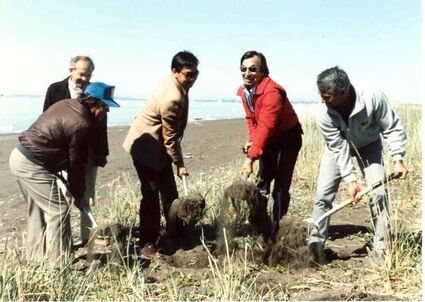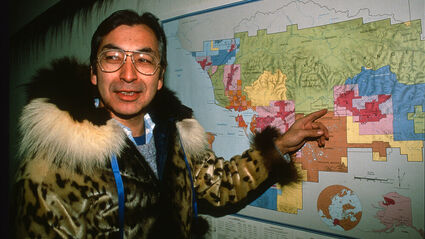Alaska Natives utilize new corporate tool
More mining land might be available if Pioneers understood Natives Alaska Native Claims – October 12, 2021
Last updated 1/6/2022 at 2:16pm

NANA Regional Corporation
The 1986 ground breaking ceremony to mark the start of construction of a port for the Red Dog zinc mine. Left to right: Frankferguson; former Alaska Gov. Bill Sheffield; former Alaska Sen. Al Adams; former Alaska Sen. Willie Hensley; former Alaska Sen. and John Qipqinia Schaeffer Jr.
Pioneer Alaskans swore that Alaska's economy would be destroyed if "the Natives" secured control of any lands in Alaska. However, they did not realize how practical and pragmatic Alaska Natives have had to be to survive and thrive in their Arctic homeland. Whatever tool was needed to survive, Alaska Natives created it with the minimal materials at hand-skin, wood, stone, jade, copper, seashells, mud, plants, flint, obsidian, snow, and ice.
With the settlement of Alaska Native Claims, the Congress offered a corporation. Here is another tool that we can utilize.
Without hesitation, Alaska Natives from one end of the four time zones to the other began to learn about the idea of a corporation and began to put life into it as a vehicle to improve their economic and social conditions.
Hunters, elders, housewives, laborers, schoolteachers, national guardsmen, carpenters, preachers, and Vietnam veterans were elected to boards of directors and hired staff, rented or built offices, to begin selecting their lands and finding local business to provide services and products.
The learning curve was steep, but as time went on, they began to understand and learn from their mistakes and successes.
NANA goes to work
Before the land claims legislation passed, I had convinced my nephew John Qipqinia Schaeffer Jr. to leave his secure position with the National Guard in Nome to come home to Kotzebue and work for Northwest Alaska Native Association, a non-profit we had created in 1966 to pursue the land claims settlement.
We had managed to turn a $10,000 gift from the Episcopal Church into $40,000 with the help of a consultant. Our region had a year head start to try to explain to our village members what the outlines of the land claims settlement was looking like and hit the ground running when the act passed.
John was selected to be the first President of NANA Regional Corporation (NANA), and we began the process of selecting land and setting up local businesses to employ our people. From the beginning, NANA's leadership was committed to creating job opportunities for our shareholders and ultimately, the primary reason we were willing to consider mining.
Modernization required income for outboard motors, fish nets, snow machines, gasoline, ammunition, store-bought food and clothing, expense money for boarding school sons and daughters.
Despite virtually no experience in business, we charged ahead and invested in a hotel in Kotzebue, in fish processing in the summer, a jade manufacturing operation, and eventually owned 10,000 head of reindeer. We built the NANA Museum to showcase our culture and provided a place for our elders and youth to perform and sell artwork to the tourists. Later we expanded into oil field service businesses in Prudhoe Bay – accommodations and food service, electrical distribution, security, equipment rentals, and a large solid waste and sewage treatment facility as well as construction and operation of oil and gas drilling rigs.
Mining in NANA DNA
By the time ANCSA was settled, and NANA was formed, the Northwest Arctic region was already familiar with the challenges and opportunities offered by mining.
In 1898, the Penelope sailed into Kotzebue Sound with a load of prospectors from California who had heard that there was gold in our region. Eventually, 30 ships came with thousands of men scouring the creeks and hills looking for gold. Some gold was found, but the discovery of gold in Nome eclipsed this effort. Yet mining became a part of our regional DNA as some of the unsuccessful gold-seekers remained to marry Inupiat women and have large families and lived their lives out among their loved ones.
Gold also brought disease, gambling, prostitution, and alcohol, but it also provided jobs and training for those of our people who were willing to make the effort.
Many stories emerged in the Upper Kobuk and along the Squirrel River as the miners interacted with our people and learned the ways of survival in the Arctic. They also learned of the Inupiaq prophet Maniilaq who predicted many life-changing events that are slowly emerging in our region-flight, the internal combustion engine, the coming of the White man, wireless communication. He also predicted the growth of a large city in the Upper Kobuk-one of the few predictions that has not yet become a reality.
Gold was discovered in the Candle area in 1901 on the Seward Peninsula and many of our people worked for various mining companies until the gold and population petered out in the 1960s. Inupiat workers traveled to Nome to work in the gold fields during the decades following the discovery in 1898 and other locations on the Seward Peninsula. Many became expert equipment operators, mechanics, and drivers.
Red Dog agreement
In spite of our history of being exposed to mining, the reality of the Red Dog mine was not assured.
Bob Baker, a Kotzebue bush pilot, reported the orange stains in the mountains to Irving Talleur with the USGS in the 1960s.
When geologists from the mining company WGM spoke to our NANA staff to explain what they knew about the mineral potential in the area, they were concerned that only the Inupiat could keep that land from being put into the contemplated Noatak National Preserve. There was literally a war going on after the passage of ANCSA between the empire-building segments of the national government-the BLM, Fish and Wildlife Service, National Forests, and the National Park Service.
In the meantime, Cominco, a Canadian mining company, had managed to stake claims in the area being selected by NANA during a lull in the "land freeze." Litigation was about to ensue. However, Cominco decided to invite John Schaeffer, President of NANA, myself, and John Shively to come up to the prospect where we visited the site, including the heavily mineralized Red Dog Creek. That site visit precipitated a trip to D.C. by John Shively, on NANA's behalf, to discuss with federal officials our list of "wants" as the status of federal lands in the area were being determined. Mining came in last behind issues such as Native allotments, reindeer grazing, and subsistence.
Mining was not high on our list at the time.
Cominco was persistent and experienced in Arctic mining and was modest, and could communicate with our staff and the mining committee that the NANA board established. Visits were made to mines in Canada and Greenland. Eventually, in 1982 NANA and Cominco signed a lease agreement that has since become a model for development of indigenous lands worldwide.
Uplifting Northwest Arctic, Alaska
NANA's decision to select the lands that now comprise the Red Dog Mine has had huge positive results for NANA and our shareholders, as well as financially uplifting all the 12 regional corporations and 175 village corporations.
NANA has retained over $800 million and distributed about $1.5 billion under the revenue sharing provision of the act. It is clear to all the village corporations that Red Dog's mine life goes to 2031. After that, many village corporations will struggle financially. That is how important Red Dog has been for the past 35 years.
For NANA, Red Dog has enabled it to not only train and employ its shareholders (some now in their third generation of mineworkers) but also to diversify into other business arenas. Without Red Dog Mine, there would be no way that we could have formed the Northwest Arctic Borough with the region-wide planning and services that it provides, including the construction of village schools.
With the help of Governor Bill Sheffield, in spite of opposition, we were able to secure from the Alaska Industrial Development and Export Authority (AIDEA) $175 million for the construction of the port and road. Since the opening of the mine, the State of Alaska has received over $1 billion from their investment.
What enabled NANA to move ahead with Red Dog was the huge effort to communicate with the shareholders in the villages. The region was united in knocking down the obstacles: securing a good agreement with a company that recognized our values; passing a state law that enabled our people to be employed on the port and road construction project; securing a Congressional law that enabled a land trade for the road through Krusenstern National Monument; and detaching the mine area from inside the North Slope Borough, allowing for the formation of our own Northwest Arctic Borough. All these challenges were met and resolved.
Mining rejuvenates rural Alaska
The next challenge is whether the mineral potential in the Ambler district will become a reality.
NANA, Ambler Metals, and Trilogy are all continuing to work on what could be one of Alaska's premier mining districts. What is clear is that mining useful minerals like copper and zinc, gold, and cobalt is one of the few economic activities that can make business sense in Alaska. What is also clear is that rural Alaska has few options in finding enterprises that will employ its people other than government-related services such as health care and education.
With oil production declining and the world moving away from petroleum, the heyday of big oil is fading. Village people pay the highest prices for imported food, fuel, snowmobiles, outboards, and everything that is flown in or shipped up from Anchorage or Seattle. Without income, the migration to larger regional centers and urban Alaska is likely to continue. Finding economically viable enterprises like mining is part of the key to keeping villagers employed.
In spite of the dire predictions from the Alaska Miners Association back in 1968, that Alaska mining would come to a dead halt, mining has been rejuvenated as a source of jobs and income to Alaskans because there are now 44 million acres of private lands with economic potential that would not be here had Congress not passed ANCSA.
I often muse that if Alaskan businessmen and miners had had open minds about the ability of Alaska Natives to adjust to circumstances, how much better off we would all be had they worked with us to secure another ten or fifteen million acres. Now, that land is in the national forests, parks, preserves, and refuges.
Learn more about Alaska mining and business organizations' opposition to the Alaska Native Claims Settlement Act at ANCSA an impossible challenge achieved in Alaska Native Claims.












Reader Comments(0)